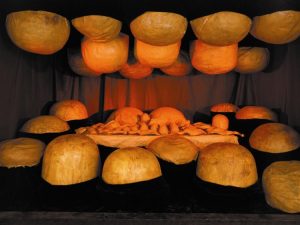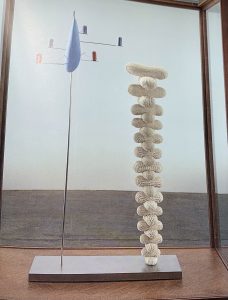 Renowned for her honest and unvarnished examination of the human psyche, Louise Bourgeois was a titan of the 20th-century art scene. As Donald Kuspit says in his essay about Bourgeois: "She was one of the great articulators of the core problems of modernity: psychic survival." Her creation(s) is proof of the ability of art to be a working-through medium; it is frequently distinguished by its visceral intensity and symbolic depth.
Renowned for her honest and unvarnished examination of the human psyche, Louise Bourgeois was a titan of the 20th-century art scene. As Donald Kuspit says in his essay about Bourgeois: "She was one of the great articulators of the core problems of modernity: psychic survival." Her creation(s) is proof of the ability of art to be a working-through medium; it is frequently distinguished by its visceral intensity and symbolic depth.
A Window into the Soul
Bourgeois used her art as a direct way to deal with her inner demons. Her childhood, marked by her father's infidelity and her mother's unwavering loyalty, cast a long shadow over her life. These experiences provided her with fertile ground from which she produced some of her most potent works.
Psychoanalysis became a cornerstone of Bourgeois’ life. While she engaged with the process for many years, she was also a staunch critic of its limitations, particularly for artists. She believed art offered a more direct and unfiltered path to the unconscious. Nevertheless, she remained in psychoanalysis for over 30 years.
Louise wrote in her diary in 1952, while she was undergoing intense analysis:
“I do not have to live in an empty world/world of vacuum (Marie Bonaparte) I can create/my own, artist world of omnipotence + fantasy/I have control space between I cannot/stand emptiness/emptiness is a space the edge of which you do/not know and you are not sure of-like falling/into space or like being dizzy. This question of space is perhaps sim/ply to have had fear of falling.”
Art as Catharsis
 Red Room (Parents) (detail) 1994
Red Room (Parents) (detail) 1994
Bourgeois saw art as a form of catharsis, a way to exorcise the pain and trauma that haunted her. Her work is a testament to the idea that art can be a powerful tool for healing and transformation.
By giving form to her inner turmoil, Bourgeois invited viewers into her world, encouraging thinking. Her work challenged societal norms and taboos, particularly around female sexuality and experience.
For example, her famous spider sculptures are frequently thought of as maternal figures. They do, also have undertones of control, fear, and protection. The physicality of the sculptures gives tangible form to these complex emotions that are so deeply ingrained in her personal history.
In 1992 Louise wrote:
“ The work of art is limited to an acting out, not an understanding. If we were understood, the need to do the work would not exist anymore… Art is a guaranty of sanity but not liberation. It comes back again and again.”
A Daughter's Trauma and Artistic Catharsis
Louise Bourgeois' relationship with her father was a complex and deeply traumatic one that profoundly influenced her art. Her father's infidelity, which she discovered as a child, cast a long shadow over her life and became a central theme in her work.
Bourgeois often described her mother as a steadfast and protective figure who stood by her during this tumultuous time. In contrast, her father was an absent and often cruel figure. This dynamic created a profound sense of betrayal and insecurity that she carried with her throughout her life.
Her art became a powerful tool for processing and understanding this complex emotional landscape. Through her sculptures, paintings, and installations, she explored themes of abandonment, betrayal, and loss. The iconic spider, a recurring motif in her work, is often interpreted as a maternal figure, offering protection and support, perhaps a reflection of the maternal strength she found in her mother. Yet, the spider also carries undercurrents of fear and control, suggesting the complex and ambivalent feelings she harboured towards both parents.
The enduring impact of childhood trauma is demonstrated by Bourgeois's work. Giving expression to her hurt and rage allowed her to not only deal with her personal suffering but also to produce art that spoke to a great number of people who had gone through similar traumas. Through the examination of the deepest recesses of the human psyche, her work offers a route to understanding and healing, serving as a reminder of the transformative power of art.
Louise wrote in her diary in 1952:
“Children show off for sympathy. My father showed his troubles, he showed off his troubles for sympathy. His asking for reassurance was asking for pity. After that, after showing himself shamefully and uselessly (because people do not show you sympathy) (...) He felt hurt and exposed and shrivelled up like a caterpillar. He was torn apart by his need to expose himself in an attempt to be loved and his modesty and fit of rage hate at having been seen. People want to pry on me, I have no privacy, nobody knew where he lived (literally). His running away was a desire to be found and run after.”
The Destruction of the Father Art Work
 "The Destruction of the Father," a powerful and visceral examination of Louise Bourgeois's complicated relationship with her father, was published in 1974. Her rage, bitterness, and desire for vengeance are clearly depicted in this piece. Plaster, fabric, wood, and metal are among the disorganised materials that come together to form a hideous, broken figure. By deconstructing the paternal authority figure symbolically, this work releases the pain and betrayal she felt in a cathartic way.
"The Destruction of the Father," a powerful and visceral examination of Louise Bourgeois's complicated relationship with her father, was published in 1974. Her rage, bitterness, and desire for vengeance are clearly depicted in this piece. Plaster, fabric, wood, and metal are among the disorganised materials that come together to form a hideous, broken figure. By deconstructing the paternal authority figure symbolically, this work releases the pain and betrayal she felt in a cathartic way.
Louise wrote in 1965
“I am ready/I have everything the/circumstances ask of me/therefore, I can fall asleep/I have an answer to everything/it is not only a right/it is a need, an obsession/I am not my father/I am defined by what I do not know/I may not know what I am but I know what I am not.”
The Spider: Maternal Protector. Controlling Force
 Bourgeois' iconic spider sculptures, often referred to as "Maman," are perhaps the most recognizable and enigmatic works in her oeuvre. These monumental figures, characterized by their imposing size and intricate web-like structures, have been interpreted in various ways.
Bourgeois' iconic spider sculptures, often referred to as "Maman," are perhaps the most recognizable and enigmatic works in her oeuvre. These monumental figures, characterized by their imposing size and intricate web-like structures, have been interpreted in various ways.
On the one hand, the spider is frequently associated with motherhood and is thought to symbolise creation, nurturing, and protection. This interpretation is reasonable considering Bourgeois's close relationship with her mother. Maternal care is evoked by the spider's protective posture and its complex web, which is symbolic of life and nourishment.
But there are also darker meanings associated with the spider. Its eight legs can be interpreted as symbols of dominance and control, representing the complicated and frequently conflicted emotions Bourgeois felt towards her father and other authority figures. Although the web is a symbol of creation, it can also be seen as a trap, implying a sense of limitation and entrapment.
It is crucial to keep in mind that Bourgeois's artwork frequently has layers and is interpreted in a variety of ways. Like many of her creations, the spider is a nuanced and multidimensional symbol that encourages viewers to consider their own feelings and associations.
Through an analysis of pieces such as "The Destruction of the Father" and the spider sculptures, we are able to comprehend the profound influence that Bourgeois's father had on her life and art. She is a living example of the resilience and creative potential of the human spirit, having been able to transform personal trauma into powerful and timeless pieces of art.
 Conscious of Unconscious Sculpture (2008)
Conscious of Unconscious Sculpture (2008)
Louise’s last diary entry from 2008
“Never let me be free from/this burden that will never/let me be free”
